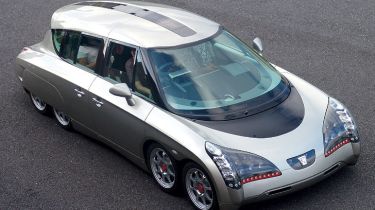Eliica eight-wheeler
It doesn't require plutonium to power its flux capacitor. It won't travel through time when it reaches 88mph. And unlike the Doc and Marty McFly's DeLorean of Back To The Future fame, it needs nothing more than a power point to keep it running.
The Eliica shows just how fast, stable and fun an electric car can be. While it might sound like a pipedream, think of other modern technology such as the mobile phone, digital camera and iPod. With each generation, they've got smaller, yet have more memory and longer battery life. Perhaps this futuristic concept is more 'current' than you'd expect...
It doesn't require plutonium to power its flux capacitor. It won't travel through time when it reaches 88mph. And unlike the Doc and Marty McFly's DeLorean of Back To The Future fame, it needs nothing more than a power point to keep it running.
Called the Eliica - short for Electric Lithium-Ion battery Car - this radical 800bhp eight-wheeler from Japan is proof that electric vehicles can be fast and fun to drive, too. Boasting a four-second 0-60mph sprint and seven-second 0-100mph time, the Eliica is faster than a Porsche 911 Turbo.
So what is it like on the road? In this world exclusive, we took the controls to find out. As soon as you climb into the snug cockpit, you realise this car is built for speed. It's more than five metres long, shaped like a bullet and carries its batteries, software and motors in a narrow chassis bed, giving it the lowest centre of gravity of any prototype we've come across.
In tests, the Eliica has recorded a top speed of 370kph (230mph), although its inventor Hiroshi Shimizu claims it could clear 400kph (250mph) in the right conditions. "When you're dealing with technology thought by most to be slow, heavy and lacking range, you must do better than any supercar," he said.
At our drive at Keio University near Tokyo, we punched the 'D' button on the dash, pointed the car down the road and flattened the gas pedal. With a faintly audible whirr of eight 100bhp in-wheel motors, the 0-60mph sprint was smooth, effortless, quiet - and surreal. The mind-boggling acceleration was on a par with that of a 500bhp GT racing car. Yet the lack of a transmission meant there were no jerky cog swaps as we were thrust back in our seat by an incredible 0.8Gs.
With that ultra-low centre of gravity, the car handles surprisingly well, and has virtually no body roll or nose-dive. It turns in sharply with well weighted steering through the front four wheels, and gives adequate feedback. And it does not feel as big or as heavy as its length and 2,400kg kerbweight suggest.
The only downsides, apart from the tiny cockpit, are that it takes 10 hours to recharge, and a production version would cost £170,000. To bring Shimizu's research back to the future, he needs a major firm's financial power behind him and the whole electric car movement.







